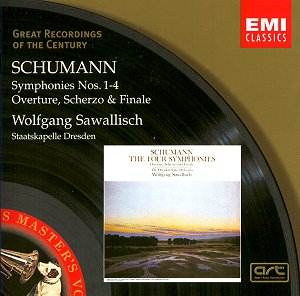In many respects Schumann is the archetypal romantic artist: deeply
influenced by literature, committed to powerfully intense emotions,
creatively aware of the virtuosity of performers. He was himself a fine
pianist, and the first twenty-three of his published compositions were
for his own instrument. His marriage to Clara Wieck in 1840 coincided
with a new phase in his creative life, concentrating on song, for in
that year alone he composed some 140 lieder. Then two years later chamber
music became his priority, with three string quartets, and a piano quartet
and quintet, the latter one of the finest examples of the genre.
Schumann also wrote four fine symphonies and three concertos, one each
for the cello, the violin and the piano, as well as choral music and
two works for the theatre. But the man himself remains something of
an enigma, a depressive whose mental anguish resulted in 1852 in a failed
suicide attempt, and incarceration in an asylum for the last two years
of his tragically short life. Much of his output is little known, but
there is no doubt that Schumann was one of the key figures of the romantic
movement and one of the great composers of the 19th century.
Recorded in 1972 and first issued the following year, Wolfgang Sawallisch's
set of the complete Schumann symphonies has seldom been out of the catalogues
since. This latest incarnation takes the form of a two disc set in EMI's
'Great Recordings of the Century' series, where it will hold a justly
secure place.
The original 3LP issue contained one extra piece which is sadly no
longer included, simply on grounds of CD space. The work in question,
the Manfred Overture, might not be regarded as one of Schumann's very
greatest works, but its omission remains a frustration. The reason can
be found readily enough from the extraordinarily even - and extraordinarily
high - quality of the music making throughout the remainder of the set.
The opening fanfare of the Spring Symphony sets the tone, confident
and supremely well phrased. The EMI recording in the ideal acoustic
of Dresden's Lukaskirche, plays its part too, affording the music ample
reverberation and richness of sonority, but alongside wonerdfully refined
details. The CD remastering has simply confirmed what was already there.
The Second Symphony, like the First, has a spacious introduction, which
leads to a lively and purposeful movement at tempo Allegro. Sawallisch
never rushes, nor does he drag. Indeed it is hard to conceive of alternative
approaches when his recordings are playing. Of course the music is great
enough to offer all manner of options to performers, but the point about
a great performance, as about a great piece, is that when one encounters
it, the experience makes one believe it to be 'the greatest'.
Rarely can the Rhenish Symphony have sounded so atmospheric, so noble
as it does in this performance. The most thrilling moment is perhaps
the prominent passage for horns towards the end of the first movement,
which Sawallisch and his engineers actually take more forcefully than
the score states. But in fact the result is nothing if not compelling,
intensifying Schumann's vision. Another landmark is the solemn slow
movement, inspired by a solemn ceremonial in Cologne Cathedral. The
shadings of dynamics, the atmospheric tensions, are very special, eloquently
unfolded with subtle attention to line and to details of texture. The
Fourth Symphony is altogether more taut, its unity of design across
four linked movements always a particular priority for Schumann. This
much revised work eventually became a miracle of nuance and subtle unity,
and the balancing of the eloquent violin solo gives clear evidence that
Schumann was a better orchestrator than his reputation has sometimes
suggested.
There is room for one extra item, and most welcome it is. The Overture,
Scherzo and Finale, as the title suggests, is an embryonic symphony,
and its vitality, its symphonic direction and purpose are all self recommending.
At less than twenty minutes it will always feature as an afterthought
rather than as a programming priority, but the quality of invention
and the vitality of the music's rhythmic activity will sustain its survival.
Again Sawallisch and the excellent Dresden orchestra give a matchless
performance, setting the standard against which others will be judged.
With such splendid standards of music making, recording and presentation,
this is a benchmark issue which fully justifies its self-generated accolade
among the pantheon of 'Great Composers of the Century'.
Terry Barfoot


